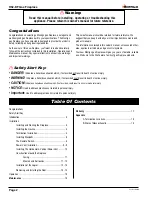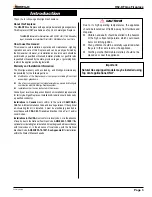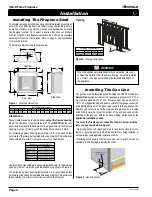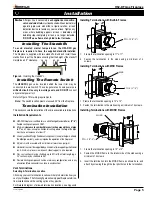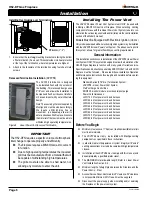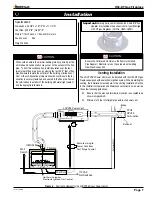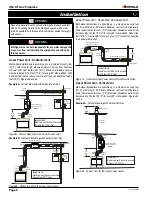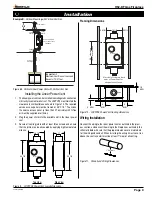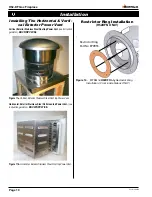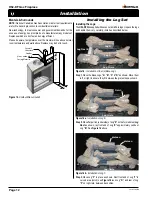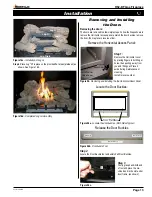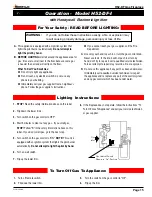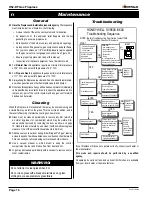
Page 16
H52-DF Gas Fireplace
Part No. XG0650
Maintenance
WARNING:
Do not attempt to clean glass when hot.
Do not clean glass with abrasive materials as any glass
etching may cause premature glass failure.
General
■
Have the fireplace and installation inspected yearly
. The inspection
must include, but is not limited to, the following:
•
A visual check of the entire vent system and termination.
•
An inspection of the explosion relief flappers and the door
gasketing to ensure a proper seal.
•
An inspection of the burner, venturi, and primary air openings.
•
An inspection of the gas valve, gas components, and pilot flame.
For your convenience a 1/8" manifold pressure tap is supplied
on the gas valve for a test gauge connection. See Figure 32.
•
Ensure proper log placement as per this manual.
•
Inspection of all optional equipment; fans, thermostats, etc.
■
For
Natural Gas
this appliance requires a minimum inlet pressure
of 5.5" W.C. and a manifold pressure of 3.5" W.C.
■
For
Propane Gas
this appliance requires a minimum inlet pressure
of 11" W.C. and a manifold pressure of 10" W.C.
■
Always keep the fireplace area clear and free of combustible materials,
as well as gasoline and other flammable vapors and liquids.
■
Do not use this appliance if
any part has been under water
. Immediately
call a qualified service technician to inspect the appliance and to
replace any part of the control system and any gas control which
has been under water.
Cleaning
When the fireplace is first activated, there may be some smoking and
a visible film may be left on the glass. This is a normal condition, and is
the result of burning of protective coatings on new metal.
■
Glass must be cleaned periodically to remove any film (which is
a normal by-product of combustion) which may be visible. Film
can easily be removed by removing the door, as shown on page
15. Handle the door carefully, and clean it with non-abrasive glass
cleaners. One of the most effective products is Kel Kem.
■
Silicone seals on inner door during initial firing will "off gas", leaving
a visual deposit of a white substance on combustion chamber walls.
This can easily be removed using normal household products.
■
Use a vacuum cleaner or whisk broom to keep the control
compartment, burner, and firebox free from dust and lint.
■
Logs may be cleaned periodically with a vacuum to remove soot or
other contaminates.
Troubleshooting
If your fireplace still does not operate correctly, consult your dealer or
the manufacturer.
All service and repairs should be performed by a qualified
agency.
All spare parts, optional fans, and optional trim finishes are available
from your local dealer or the manufacturer.
- Tu
rn Gas Supply Of
f
- Set thermostat to
call for heat
SV9500 / SV9600
is powered
(24V
AC nominal
)
HSI
Terminals
NOTE:
Before T
roubleshooting, Familiarize
Y
ourself With
The Startup
A
nd Checkout Procedure.
ST
AR
T
HONEYWEL
L
SV9500 /9600
Tr
oublshooting Sequence
INSE
T
NO
CHECK:
- Line voltage power
- Low voltage transformer
- Limit Controller
- Thermostat
- Wirin
g
-
Air proving switch on
combustion air blower system
-Vent damper (if used) is open
and end switch made
NO
NO
YES
NO
YES
Unplug Pilot Burner Cable,
Measure V
oltage at
SV9500/SV9600 HSI
T
erminals (24V
AC
Nominal, see INSET)
Replace
SV9500/
SV9600
Igniter warms up and
glows red.
YES
YES
NO
YES
NO
Pilot
Valve opens.
Replace Igniter /
Flame Rod Assembly
Replace SV9500/SV9600
NO
NO
YES
YES
Turn gas on.
Pilot Burner Lights?
Main Valve opens?
SYSTEM OK
Discard old Igniter /
Flame Rod Assembly
Measure
Vo
lume to
SV9500 / SV9600 Vo
ltage
must be at least 19.5 VA
C
Check
Transformer
Line
Vo
lt
Supply
Replace Igniter /
Flame Rod Assembly
Replace
SV9500 /
SV9600.
Save old
Igniter/ Flame
Rod Assembly
for service.
Replace Igniter / Flame
Rod Assembly and retain.
Restart troubleshooting
Sequence. Does main
valve open?

